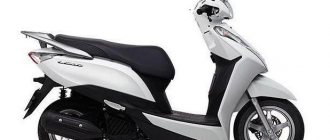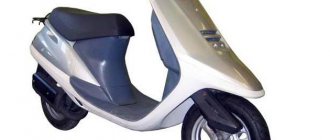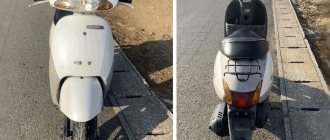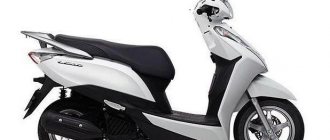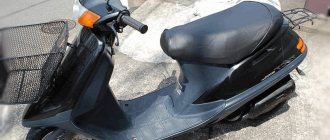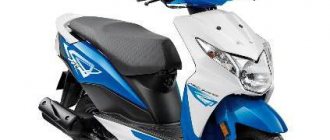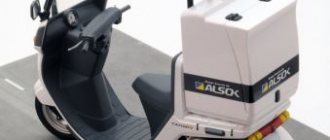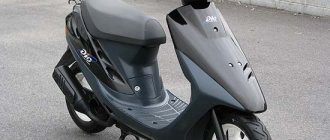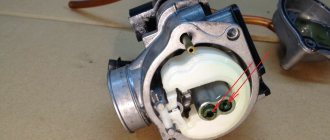Appearance
A distinctive feature of the scooter is the shape of the plastic. In the front part it has an almost rectangular shape and is, in fact, a shield. Engineers implemented this idea to improve roominess characteristics, but at the same time aerodynamics suffered.
The Honda Lead AF20 is equipped with a powerful headlight with 2 lamps.
The front optics have a narrow rectangular shape, the turn signals are fused with the headlight on the steering wheel. The scooter base is a steel frame AF20 and durable plastic with metal fasteners. You can attach a basket to the front of the scooter; on the driver’s side there is a fairly large glove compartment, where, in addition to keys and documents, more than one bottle of water can fit.
Honda Lead AF20 is a two-seater scooter.
The profile shows an elongated and wide seat that can easily accommodate 2 people. Its rear end is slightly raised and there is an extended trunk with a handle behind the passenger. The rear optics are presented in the form of a strip and are placed in the lower part of the body, next to the rear wheel.
Honda Lead AF20 1998.
Interesting moment! Due to the specific shape of the plastic, the scooter has a large width, which improves the comfort of the driver and passenger.
Scooter parameters
Honda Lead AF20 has the following parameters: 1755 mm (length), 715 mm (width), 1060 mm (height). The wheelbase is 1235 mm, ground clearance is 110 mm. The dry weight of the scooter is as much as 84 kilograms, the load capacity is up to 200 kg.
Under the seat of the Lead AF20 there is a large glove compartment for hand luggage weighing up to 10 kg.
Technical characteristics of Honda Lead AF20
Engine brand – AF20E, maximum speed – 60 km/h, gas tank volume – 7.2 liters. Front wheel: 100/90-10, rear wheel: 100/90-10.
Engine AF20E
The AF20E single-cylinder two-stroke engine with forced air cooling has a power of 6.4 hp at 6500 rpm, maximum torque is 7.2 N*m. Piston stroke – 41.4 mm, diameter – 39 mm. Compression when rotating the knee using an electric starter is 11 kg/cm.
The Honda Lead AF20 is equipped with a 2-stroke AF20E engine, paired with a CVT.
Transmission
The transmission is a standard CVT with 3 gears. The front brake is disc, the rear is drum.
Important! The Honda Leaf AF20 is equipped with a reliable Nissin brake system, which is installed on well-known brands of Japanese motorcycles.
The main advantage of the scooter is its suspension. A reinforced lever fork is installed at the front, which handles road unevenness well. The rear suspension consists of a standard shock absorber and spring assembly.
Honda Lead AF 20: front suspension – pendulum lever fork, rear – shock absorber with spring.
Fuel consumption Honda Lead AF20
At a cruising speed of 30 km/h, fuel consumption according to the passport is 1.72 liters. Actual fuel consumption may vary greatly depending on the “fatigue” of a particular model, road and climatic conditions. Owner reviews of the Honda Lead AF20 state a figure of about 2.3 liters per 100 km.
- Engine – AF20E, 2-stroke, 1-cylinder;
- Power unit volume – 49 cm3;
- Cylinder diameter – 39.0 mm;
- Piston stroke – 41.4 mm;
- Compression ratio – 7.1;
- Engine power, (hp / rpm) – 6.4 /6500;
- Torque, (H*m/rpm) – 7.2/6000;
- Power supply system – carburetor (РВ80Э);
- Cooling – air;
- Average fuel consumption – 1.72 liters/100 km (at 30 km/h);
- Maximum speed – 60 km/h;
- Gas tank volume – 7.2 liters;
- Oil tank – 1.2 liters;
- Front brake type – disc;
- Rear brake type: drum;
- Front suspension – pendulum wishbone fork;
- Rear suspension - shock absorber with spring;
- Gearbox – variator (wedge-shaped);
- Start type – kickstarter/electric starter;
- Tire size, (front/rear) – 3.50-10 2PR;
- Scooter dimensions, (L x W x H) – 1755 x 715 x 1060 mm;
- Ground clearance – 110 mm;
- Seat height – 735 mm;
- Wheelbase – 1235 mm;
- The weight of the scooter is 84 kg.
Fuel consumption of Honda Lead AF20 is about 2.3 liters per 100 km.
Honda Lead 50 AF-20
The Japanese scooter Honda Lead 50 cm3 (Honda Lead) with the factory index AF-20 is one of the most popular and successful models of this famous brand
It’s not for nothing that this model did not leave the factory assembly line for almost 10 years. Such success and popularity of this moped was brought by its amazing design reliability and correct and well-thought-out functionality. This scooter differed favorably from its brothers and competitors by its longer wheelbase and overall overall dimensions, which mopeds from other manufacturers could not boast of. Most likely, the dimensions of this scooter can be safely attributed to an older class of cubic equipment, such as the Honda Lead 100 or Yamaha Grand Axis 100.
The Honda Lead 50 moped is equipped with a two-stroke internal combustion engine and forced air cooling. The 49.9 cm3 engine produced a serious, for those times, power of 6.4 horsepower, which easily accelerated this scooter well beyond 60 km/h, which was displayed on its dashboard. This AF20E engine turned out to be not only fast, but also a very reliable unit, some copies easily lasted distances of 100 thousand km. And this is already a very serious indicator for a small-capacity engine. In general, the Honda Lead 50 scooter is perfect for both a beginner scooter rider and an advanced pilot with extensive driving experience. The device is convenient and comfortable according to almost all selection criteria of even the most demanding consumer. City asphalt or a country clearing will be native elements for this scooter, and in both cases it will be equally stable and understandable to the driver. A moped with good dynamics and excellent speed performance, comfortable suspension and powerful brakes, comfortable fit and timeless body design
The suspension of this scooter deserves special mention. The rear shock absorber works in conjunction with a reinforced spring and forms a single suspension system. The front suspension is a pendulum type with an anti-dive system that allows adequate braking when the front brake is applied sharply. As for the brakes of this model, everything is at a very high level. At the front there is a disc brake with two pistons, and at the rear the scooter is stopped by drum mechanisms of increased diameter. This pair allows you to brake more than confidently on almost any road and on any surface.
The ergonomics of the Lead 50 moped are beyond praise. In addition to the impressive size of the scooter itself, this device has a full-fledged seat for two people and side bolsters for the legs of the rear passenger, which makes trips for two people over any distance comfortable and convenient. In addition, the scooter has an amazing and reliable solution for the head light and rear lights: the front headlight and rear light have two bulbs, which work simultaneously and insure each other in case one of them burns out. And that is not all. On this scooter, you can separately turn on the side lights, low beam or high beam. Oddly enough, this feature came from the world of large and serious motorcycles and was used for a small scooter with a minimum engine capacity. For greater convenience, there are two very large containers for all kinds of things: one is under the seat, and the second is under the steering column. Another big advantage of this model is its dashboard. It is very informative with a large number of switches and indicator lights, all meanings can be read easily and quickly.
You can buy this scooter inexpensively in our stores located in convenient places in Moscow. If necessary, equipment is delivered using the company’s own transport or third-party carriers.
Comparison of Lead AF20 and Lead AF48
Honda Lead AF48 is a more recent model, production of which began in 1998. Compared to the AF20, it has slightly larger dimensions: length – 1795 mm, width – 720 mm, height – 1060 mm. The wheelbase size of the AF48 is 1255 mm, which is 20 mm longer than that of the AF20. The weight of the Lead AF48 is 91 kg, which is 7 kg heavier than the AF20 scooter.
On the left in the photo is a 2002 Honda Lead AF48, on the right is a 1994 Lead AF20.
The Lead AF48 is equipped with a two-stroke single-cylinder AF48E engine with forced air cooling. Maximum speed – 60 km/h (electronically limited), maximum power – 5.9 hp at 6750 rpm, piston stroke – 39.3 mm, diameter – 40 mm. The rear suspension is a shock absorber with a spring assembly; a telescopic fork is installed at the front. In terms of brakes, the scooters are the same: front – disc, rear – drum.
Lead AF48 is more suitable for the city, as it has a telescopic fork. It handles road unevenness worse and will not be as good on bumps - the Lead AF20 is more suitable for the countryside.
Price Honda Lead AF20
You can buy a Honda Lead 50 AF20 on the Russian market of used models or order it without mileage in the Russian Federation from Japan. In this case, you should take into account the costs of delivering the scooter by a transport company to the destination city. The average price for a scooter in good condition on the used market is 35 thousand rubles. Without mileage in the Russian Federation, a Honda Lead AF20 will cost approximately 55-60 thousand rubles.
You can buy a Honda Lead AF20 without mileage in Russia through advertisements on the website Drom.ru
Honda Lead af-20
Good day to everyone who has looked into this topic!
It’s been two years since I sold Dio, and now as soon as the snow melts, my palms itch as I see a scooter on the road. So I decided to take a chunk of money out of the family budget and buy myself two wheels.  .
.
I dreamed, of course, of taking a Honda Gyro Canopy, but the prices for them now are just outlandish, so after thinking and searching through Avito, I opted for the 50 cc Lida. I also looked at this model when I was still riding Dio, because of the wishbone front suspension, since I often drove along the Moscow Ring Road, and constantly hit potholes with a fork, which you drive through in a car without paying the slightest attention. Even then I wanted to have something more comfortable.
I finally picked it up “without driving across Russia” from an office on Serebryakov Avenue. Externally, of course, it was damaged by plastic, plus there was no central stand, a seat covered with a rag and a dead battery. Well, actually there was a discount on all this.
They started it from kickstarter, at first I didn’t want to, it was clear that it had been standing for a long time, they wanted to spray it with “quick start”, but I didn’t let them pour this crap, and in the end the motor growled pleasantly and surprisingly evenly.
The battery was dead in the trash - even the signal barely wheezed when turned on. Later I measured - 1.2 v of voltage remained in it. But still, I liked Lid and took him.
By the way, I ask the owners of this unit to join the topic, share their experience in repair and maintenance, I will be very grateful.
Since I took it on the first of March, it was still too early for rides, I decided, of course, to sort it out little by little.
The goal was primarily to bring it to normal technical condition.
I definitely need a scooter for this season, since I’m going to warmly transport my workshop () to my summer cottage near Mozhaisk. You have to at least somehow settle down in the new place, get your teeth into it, find some amount of work, or get a job somewhere for the first time. It will be necessary to set up a temporary house made of containers + a workshop. Well, then build slowly.
So for traveling on local business, it will help me save a lot.
I began to take it apart little by little and marvel at the reliability of small Japanese equipment and human carelessness.
Unfortunately, I didn’t take detailed photos of the repair; as always, I didn’t think that I would post it somewhere. But I will show you what I have.
By the way, I found a good channel on YouTube for repairing scooters, “Pit Stop Workshop.” I got a lot of information from there. I used to drive a Dio and didn’t look much into it, the most I did was replace the variable valve belt and adjust the carburetor.
Here, as the scooter was disassembled, for some reason interest in this topic increased, even I did not expect it. It seems that there is some kind of hole there, but no, it turns out that everything is interesting - both the device and what problems appear and how it is all solved. Not like a car, of course, but addictive!
A couple of photos of the disassembly:
